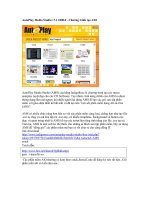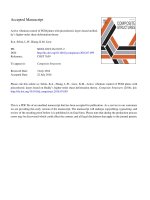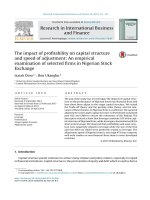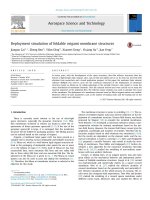1 s2 0 s2212827118304104 main
Bạn đang xem bản rút gọn của tài liệu. Xem và tải ngay bản đầy đủ của tài liệu tại đây (981.66 KB, 6 trang )
Available online at www.sciencedirect.com
ScienceDirect
Procedia CIRP 72 (2018) 1022–1027
www.elsevier.com/locate/procedia
51st CIRP Conference on Manufacturing Systems
Smart Packaging: Opportunities and Challenges
Dirk Schaefera* and Wai M. Cheungb
a
Division of Industrial Design, The University of Liverpool, Brownlow Hill, Liverpool, L69 3GH, United Kingdom
Department of Mechanical and Construction Engineering, University of Northumbria, Newcastle Upon Tyne, NE1 8ST, United Kingdom
b
* Corresponding author. Tel.: +44-151-794-2082. E-mail address:
Abstract
The global market for smart packaging is expected to reach $26.7bn by 2024. Smart packaging refers to packaging systems with
embedded sensor technology used with foods, pharmaceuticals, and many other types of products. It is used to extend shelf life,
monitor freshness, display information on quality, and improve product and customer safety. In addition, smart packaging offers
new business opportunities based on digitization and thus fits into the broader realm of Industry 4.0. In this paper, the authors
provide an introductory overview of smart packaging and discuss its underlying base technologies. This is followed by a
presentation of potential benefits and emerging opportunities in the packaging sector, contrasted by a number of challenges that
first have to be overcome for smart packaging to reach its full potential. Finally, conclusions are drawn and an outlook towards the
future, critical research areas to work in, and potential lessons to be learned from associated areas are presented.
© 2018 The Authors. Published by Elsevier B.V.
Peer-review under responsibility of the scientific committee of the 51st CIRP Conference on Manufacturing Systems.
Keywords: Smart packaging; Active packaging; IIoT; Cyber-physical systems; Industry 4.0.
1. Introduction
The main purpose of packaging is to protect a product against
deteriorative effects caused by exposer to and usage in the
external environment. In addition, product packaging serves as
an effective means of marketing to communicate with the
consumer. It comes in various shapes and sizes and, as a user
interface, provides consumers with both ease of use and
convenience. The main functions of product packaging have
been categorised as follows [1]: protection, communication,
convenience, and containment. For example, packaging used
in food products usually serves the following purposes [2]:
• To prevent the product from leaking or breaking, and
to protect it against possible contaminations.
• To communicate important information about the
contained food product and its nutritional content and
to provide cooking instructions.
• To provide convenience such as allowing consumers
to reheat the contained food in a microwave.
• To provide containment for ease of transportation and
handling.
However, traditional packaging is no longer sufficient due
to continuously increasing customer experience expectations,
increasing product complexity, and, most recently, national and
international initiatives towards fostering a circular economy
and minimising the carbon footprint of manufactured products
[3]. Innovative packaging with enhanced functionality is also
required to accommodate a variety of additional consumer
needs. Examples include offering foods processed with fewer
preservatives, products that meet increased regulatory
requirements, and packaging that allows for cradle-to-grave
tracking and thus may serve as a protection against lawsuits. In
addition, smart packaging serves as a means of expanding
markets in the context of globalization, helps to accommodate
stricter national and international food safety regulations and
even serves as a protection against potential threats of food
bioterrorism [4].
Over the past two decades, terms such as active packaging,
intelligent packaging and smart packaging have emerged in
literature and are often used interchangeably [4]. They all refer
2212-8271 © 2018 The Authors. Published by Elsevier B.V.
Peer-review under responsibility of the scientific committee of the 51st CIRP Conference on Manufacturing Systems.
10.1016/j.procir.2018.03.240
This is a resupply of March 2023 as the template used in the publication of the original article contained errors. The content of the article has remained unaffected.
Dirk Schaefer et al. / Procedia CIRP 72 (2018) 1022–1027
1023
to packaging systems used for foods, drinks, pharmaceuticals,
cosmetics and many other perishable goods. Strictly speaking,
one should actually distinguish between intelligent, smart, and
active packaging.
• Kerry et al. [5] defined active packaging as
“incorporation of certain additives into packaging
systems with the aim of maintaining or extending
product quality and shelf-life”.
• Otles and Yalcin [6] defined intelligent packaging “as a
packaging system that is capable of carrying out
intelligent functions (such as sensing, detecting, tracing,
recording and communicating) to facilitate decisionmaking to extend shelf life, improve quality, enhance
safety, provide information, and warn about potential
problems”.
• Several other authors, including Otles and Yalcin [6]
and Vanderroost et al. [2], defined smart packaging as
“one that possesses the capabilities of both intelligent
and active packaging. Smart packaging provides a total
packaging solution that on the one hand monitors
changes in the product or the environment (intelligent)
and on the other hand acts upon these changes (active)”.
Intelligent packaging system use communication functions
to facilitate decision-making aimed at preserving food quality,
extending shelf life and improving overall food safety [11]. It
is capable of carrying out intelligent functions such as sensing,
detecting, and tracing, recording and communicating certain
types of information [12]. Accordingly, intelligent packaging
systems consist of hardware components such as timetemperature indicators, gas detectors, freshness and/or ripening
indicators [10] and radio frequency identification (RFID)
systems [5].
The required functions can be implemented and realized via
indicators and sensor devices to communicate the pertinent
information. Indicators inform about a detected change in a
product or its environment, for example a change in
temperature or pH level [4]. In food packaging, this technology
is often complemented with biosensors to detect, record and
transmit information related to potential biological processes
and reactions occurring inside the package, for example
changing oxygen and freshness levels [4, 11].
In this paper, the authors discuss the background of
smart/active packaging technology and provide a brief
overview of its main application fields and opportunities for
adding value in the global market place. They also discuss
related challenges and outline steps towards future research on
this topic.
According to Vanderroost et al. [2], “smart packaging provides
a total packaging solution that on the one hand monitors
changes in a product or its environment (intelligent) and on the
other hand acts upon these changes (active)”. Smart packaging
utilises chemical sensors or biosensors to monitor the quality
and safety of food all the way from producers to consumers
[13]. As with the previously discussed technology, smart
packaging utilises a variety of sensors for monitoring food
quality and safety, for example by detecting and analysing
freshness, pathogens, leakages, carbon dioxide, oxygen, pHlevel, time or temperature.
The exact functionalities of specific smart packaging
solutions vary and depend on the actual product being
packaged, for example, food, beverages, pharmaceuticals, or
various types of health and household products [13]. Similarly,
the exact condition to be monitored, conveyed, or adjusted vary
accordingly.
Smart packaging allows to track and trace a product
throughout its lifecycle and to analyze and control the
environment inside or outside the package to inform its
manufacturer, retailer or consumer on the product’s condition
at any given time.
2. Underlying technologies of packaging systems
Packaging base technologies vary not only in terms of
hardware, but also in the amount and type of data they can
generate, capture, process and distribute [7].
2.1. Active packaging
Active packaging is a first alternative to traditional packaging
methods. It refers to an innovative food-packaging concept
introduced in response to continuous changes in consumer
demands and market trends. Active packaging technology
embeds components into the packaging that are able to release
or absorb substances from or into the preserved food or the
surrounding environment to sustain quality and prolong shelf
life [8]. Advantages of using active packaging for perishable
goods include reduction of the amounts of active substances,
reduction of localisation activity and migration of particles
from film to food, and elimination of unnecessary industrial
processes that might introduce bacteria into the product [9].
The components frequently used in active packaging systems
include oxygen scavengers, ethylene scavengers, flavour and
odour absorber/releaser, antimicrobial and antioxidants [10].
2.2. Intelligent packaging
According to Kerry et al. [5], intelligent packaging is mainly
used ‘to monitor the condition of packaged foods such as meat
to capture and provide information on the quality of the
packaged good during transport and storage’.
2.3. Smart packaging
3. Application areas and market opportunities
3.1. Application areas
Based on findings by Pereira et al. [14], more than 6 million
cases of foodborne diseases occur every year in the United
States, potentially leading to more than 9,000 deaths. It is
estimated that in Spain, there are 60 cases of foodborne disease
per 100,000 inhabitants every year. Hence, it is not surprising
that one of the key application areas of smart packaging
technology is the development of biosensors to detect
pathogens in food. Other areas of application include moisture
absorbers, antimicrobial packaging solutions, carbon dioxide
This is a resupply of March 2023 as the template used in the publication of the original article contained errors. The content of the article has remained unaffected.
Dirk Schaefer et al. / Procedia CIRP 72 (2018) 1022–1027
and storing of goods [19]. This massive waste of food
constitutes a significant financial burden for the food industry
to cope with, hence designing adequate packaging for
perishable goods is of utmost importance in terms of allowing
for longer transportation and storage periods and thus extended
shelf-life [5]. However, the design and manufacture of
adequate smart packaging technology is quite challenging from
an industrial point of view, for a number of reasons (see Fig 2)
and the grey area represents opportunities.
US $ Million
4.1
•
3,600
3,000
2,360
1,690
1,500
1,400
1270
•
1,000
500
0
USA
Japan
Australia Germany
UK
Fig 1. Predicted global market growth rate
4. Research challenges and opportunities
According to the United Nations [18], approximately one-third
(over 1.3 billion metric tons) of all edible products for human
consumption is lost or wasted annually. This is due to poor
practices and conditions in terms of harvesting, transporting
Thin film
electronics
Research challenges and
opportunities of smart
packaging
Info
rma
tion
t
Cos e s s
en
v
i
t
c
e ffe
Fig. 2. Challenges and opportunities of smart packaging
4,000
2,000
Anti
mi
pack crobial
agin
g
W
re as
du te
cti
on
no y
Na olog
hn
te c
Predict Packaging Global Market Growth Rate by 2026
Industrial
Internet
of
Things
Real time
capabilities
The global market for advanced packaging systems was at a
level of $31.4 billion in 2011 and $33.3 billion in 2012,
respectively. It is predicted to grow to $44.3 billion in 2017/18
[12]. The global demand for electronic smart packaging is
expected to grow to over $1.45 billion over the next decade
[16]. According to findings by Fuertas et al. [17], in the US
this type of packaging is anticipated to keep developing with
an annual growth rate of 7.4%, reaching US $3,600 million in
the next decade (see Fig. 1). The second largest market is Japan
reaching the equivalent of US $2,360 million, followed by
Australia with the equivalent of US $1,690 million; the UK, at
the equivalent of US $1,270 million; and finally Germany, at a
level equivalent to US $1,400 million.
2,500
ss
Cy
be
rs
e
3.2. Global market opportunity
3,500
ne
bus i
Ne w ode l
m
e
tiv ls
Ac e ria
t
ma
emitters, oxygen scavengers, and antioxidants embedded into
the packaging.
In general, smart packaging technology has a wide variety
of potential application fields from monitoring food safety and
drug use, to tracking postal delivery of items via embedded
security tags [8]. From a customer perspective, such
opportunities are perceived as value-added benefits. In this day
and age of people being permanently connected to the Internet,
new ways of tracking and monitoring purchased goods with
associated apps has turned into an important business
opportunity for companies to increase customer satisfaction
and loyalty. Pacquit et al. [15] identified that smart packaging
may also be used to identify supply chain inefficiencies, reduce
costs and errors, improve product performance and ultimately
increase profit margins.
cu
rit
y
1024
•
Challenges
Antimicrobial packaging is gaining interest from
researchers and industry alike due to its potential for
providing quality and safety benefits [5, 20, 21]. Future
research in the area of microbial active packaging
should increasingly focus on naturally-derived
antimicrobial agents, bio-preservatives and biodegradable solutions. For example, bio-degradable
packaging technology with improved quality and safety
has already resulted in a number of innovations in the
packaging sector and contributed toward the
enhancement of food quality and safety, proving the
feasibility of bio-active functional components.
Further development of so-called active materials is
also important as they are able to preserve both their
original mechanical and barrier properties [12]. This
will further increase food safety and extend shelf life.
Realini and Macros [12] concluded that ‘the use of
active compounds derived from natural resources is also
expected to continue growing as well as the
incorporation of biodegradable packaging materials as
carrier polymers’.
Research and development of thin film electronics to
integrate into packaging technologies is a challenging
area. Vanderroost et al. [2] point out that the integration
of thin film electronics into printed and flexible sensor
systems can be used for temperature tracking to monitor
This is a resupply of March 2023 as the template used in the publication of the original article contained errors. The content of the article has remained unaffected.
Dirk Schaefer et al. / Procedia CIRP 72 (2018) 1022–1027
•
•
•
perishable goods. However, performance is still an
issue to be resolved.
It is well known that that waste generated from smart
packaging is mostly unsustainable for recycling and as
such poses a major challenge to industry [22]. Although
government policies for the recycling and treatment of
packaging waste have been in place for quite some time
[23], practical experience shows that the recycling of
some types of packaging waste proofs difficult [24].
Therefore, one of the main challenges in the design and
manufacture of smart packaging is to advance research
on the treatment and recycling of packaging waste, or,
for example, to find more suitable materials that may
allow for the implementation of sensor and
communication functionalities that are bio-degradable.
Food waste can occur at different points in the food
supply chain [25]. As previously alluded to, as soon as
food enters its supply chain its packaging starts to play
an important role in keeping it safe, fresh and to its
highest quality. However, further research to improve
packaging along this entire lifecycle is required:
o A common weakness in packing relates to
unreliable sealing of a product, which, for
example, may cause problems such as grain
spillage from sacks resulting in the attraction of
rodents that in turn may result in larger infestations.
o Regulations on the selling and further distribution
of perishable goods damaged during transportation.
o Food that is about to reach its end-of-life point
may have to be processed differently, for example
to avoid feeding it back to livestock, which might
lead to the outbreak of major epidemics causing
huge financial harm.
Kuswandi et al. [13] propose that the growing need for
information to be embedded in packaging is particular
challenging for food-producing companies. They
conclude that further research into this will drive the
need for smarter packaging:
o
More and more consumers expect to be able to get
easy access to information ranging from the
ingredients of a product, their origin, and the
conditions the product has been exposed to whilst
in transport to the grocery store or their home.
o
Smart labelling and stickers are expected to be
capable of communicating directly with the
customer via thin film devices providing visual
food safety information.
o
Visual safety and disposal instructions on
pharmaceutical and health products should be
provided to inform consumers on how to safely
consume the product and how to dispose of it after
expiration.
o
Drug delivery systems based on smart packaging
technology are expected to further increase health
services and patient safety by relaying pertinent
information to doctors and health care providers.
Along the same lines, they may help to prevent
misuse and fraud.
1025
4.2 Opportunities
•
•
•
•
Nanotechnology is likely to play an important part in
the near future, keeping in consideration the safety
concern associated with packaging. According to Majid
et al. [26], a key opportunity is the need and
development of suitable and safe advanced packaging
materials. These materials are to be used to control the
release of active agents in conjunction with sensors
embedded in the packaging system.
The Industrial Internet of things (IIoT) is a concept
aimed at providing a globally interconnected network
infrastructure for connecting objects to the cyberphysical world. It allows for the tracking and control of
devices equipped with sensors and actuators. For
example, packaging objects equipped with RFID tags
[27] can easily be tracked along their journey from
manufacturer to customer. For e-commerce delivery
services UPS estimated that 1% of their shipments are
lost or damaged [28]. UPS deliver about 4.6 billion
packages annually and this is equivalent to 4.6 million
packages are either lost or damaged every year. Hence
by the integration of smart packaging this could
potentially reduce UPS parcel loss significantly. By
2025, not only mobile phones, tablets, laptops and
personal computers will be part of the Internet of
Things, other appliances such as food packages,
furniture, cars, boats, and even manufacturing machines
and entire factories will become part of the Industrial
Internet of Things (IIoT) as well [29].
Real-time capabilities and CPS. One of main areas
for further advancement and improvement in packaging
technologies is that of monitoring, managing and
controlling the conditions of goods in real time. This
capability will significantly affect food safety,
consumer health and reduction of waste. A precursor
for this is the existence of a reliable IIoT infrastructure
and the associated Information and Communication
Technologies embedded into both the packaging and the
entire supply chain of a product concerned. Technically
speaking, this is referred to as the creation of cyberphysical production and delivery networks at both
vertical (within one company) and horizontal levels
(across several companies). To further benefit from
such a digitization of the cradle-to-grave lifecycle and
supply chain, Artificial Intelligence can be expected to
soon play a more significant role in improving machine
learning, data mining and decision support systems that
are able to adjust processes in real time and on the basis
of big data [2].
Cybersecurity. Despite the many new possibilities and
emerging technologies, a major concern is that of
cybersecurity [30]. Existing internet technologies are
plagued by cybersecurity and data privacy issues that
may present major challenges. If these challenges are
not appropriately addressed, the full potential of smart
packaging as one of the most exciting application
domains in the context of Industry 4.0 may never be
reached. The modern Internet security landscape is
This is a resupply of March 2023 as the template used in the publication of the original article contained errors. The content of the article has remained unaffected.
1026
•
Dirk Schaefer et al. / Procedia CIRP 72 (2018) 1022–1027
characterized by attacks that are voluminous, constantly
evolving, extremely fast, persistent, and highly
sophisticated. These characteristics impose significant
challenges
on
preventive
security
services.
Consequently, methodologies that enable autonomic
detection and response to cyberattacks should be
employed synergistically with prevention techniques in
order to achieve effective defense-in-depth strategies
and robust cybersecurity systems. This is true for all
cyber-physical systems in general, not just for smart
packaging.
New Business Models. Along with the ongoing
digitization in the smart packaging sector, new business
models capitalizing on the new opportunities have to be
developed [31]. Customers are more and more looking
for an experience of sorts, hence the industry sector is
seeing a shift from products (past paradigm) towards
product-service-systems (new paradigm). Traditional
value chains and business models are expected to soon
come under increasing pressure.
Big data and
digitization across the sector have already begun to
challenge them.
Reflecting on past disruptive
technologies, it is evident that there is a strong
correlation between technological and business model
developments and that employing the latest technology
in concert with innovative business models is a recipe
for success (see Fig. 3). This can be expected to hold
true for the evolving smart packaging arena as well.
Given the strong interest of the manufacturing sector per
se in big data analytics [32], it does not come as a
surprise that idea based on data-driven business
opportunities and models currently dominates the
discussion.
Fig. 3. Relationship of technology and business models [33]
As mentioned earlier, smart packaging provides a total
packaging solution encompassing both active and intelligent
capabilities. Considering the myriad of before-mentioned
challenges, combining and integrating these active and
intelligent packaging concepts into fully functional and reliable
systems is an enormous task and expected to provide an
exciting ground for both fundamental and applied research for
years to come.
5. Concluding remarks
Smart packaging relies on the development of sensor
technology and materials to inform its quality, safety, shelf-life
and usability. Therefore, the future of smart packaging to
enhance current packaging technology requires work on a
number of aspects:
• Enhance sensor technology to incorporate both smart
and conventional materials, adding value and benefits
across the entire food packaging supply chain.
• Future senor technology will consist of thin film
electronics, smart materials and Nano technologies to be
integrated in the packaging. Hence, they need to be
suitable for printing technology and mass production,
represent only a low-cost relative to the value of the
food product, easy to use, environmentally friendly as
well as safe to use for the humans.
• In food products, new and advanced smart packaging
must focus on advanced food safety aspects to be able
to detect microbial growth, oxidation and improve
tamper visibility. Furthermore, this new technology
should also increase a product’s shelf-life and offer the
capability of tracking, convenience and sustainability.
• Treatment of recycling packaging and food wastes can
be solved by developing integrated packaging sensors.
These senora may store information on, for example, the
material(s) that the package is made of, food expiration
date, oxygen level, temperature and pH levels etc. Such
information can be communicated to food suppliers,
distributors and even packaging recycling businesses
via the Industrial Internet of Things.
• From an Information and Communication Technology
(ICT) point of view, the actual integration of smart
packaging into the growing number of horizontally and
vertically integrated production networks [34] as part of
the Industrial Internet of Things and Internet of Services
requires the manufacturing sector to overcome a number
of challenges, including a seamless integration of their
internal Information Technology (IT) and Operational
Technology (OT). This so-called IT/OT convergence is
a precursor for enabling the distributed and largely
autonomous smart manufacturing networks of the future
[35]. Along the same lines, new ways of addressing
cybersecurity and ensuring data security and IP
protection along the entire lifecycle are of utmost
importance.
This paper serves as a foundation for understanding the
opportunities and challenges of smart packaging and leads
into a number of research areas to be addressed. Building
on this work, the authors seek to derive a 5-7 year research
roadmap for the field and to further investigate suitable
research directions to tackle the challenges identified.
This is a resupply of March 2023 as the template used in the publication of the original article contained errors. The content of the article has remained unaffected.
Dirk Schaefer et al. / Procedia CIRP 72 (2018) 1022–1027
References
[1]
[2]
[3]
[4]
[5]
[6]
[7]
[8]
[9]
[10]
[11]
[12]
[13]
[14]
[15]
[16]
[17]
[18]
[19]
Robertson GL. (1993). Food packaging: principles and practice.
Marcel Dekker, New York. Pages 686.
Vanderroost, M., Ragaert, P., Devlieghere, F., De Meulenaer, B.,
(2014). Intelligent food packaging: The next generation. Trends in
Food Science & Technology, 39(1): 47-62.
Cheung, W.M., Leong, J.T., Vichare, P (2017), Incorporating lean
thinking and life cycle assessment to reduce environmental impact
of plastic injection moulded products, Journal of Cleaner
Production, 167: 759-775.
Yam, K.L., Takhistov, P.T., Miltz, J., (2005). Intelligent packaging:
concepts and applications. Journal of food science, 70(1).
Kerry, J.P., O’grady, M.N. and Hogan, S.A., (2006). Past, current
and potential utilisation of active and intelligent packaging systems
for meat and muscle-based products: A review. Meat science, 74(1):
113-130.
Otles, S., Yalcin, B., (2008). Intelligent food packaging. LogForum
4, 4, 3.
Heising, J.K., Dekker, M., Bartels, P.V., Van Boekel, M.A.J.S.,
(2014). Monitoring the quality of perishable foods: opportunities
for intelligent packaging. Critical reviews in food science and
nutrition, 54(5): 645-654.
Arvanitoyannis, I.S., Stratakos, A.C., (2012). Application of
modified atmosphere packaging and active/smart technologies to
red meat and poultry: a review. Food and Bioprocess Technology,
5(5): 1423-1446.
Bolumar, T., Andersen, M. L., Orlien, V. (2011). Antioxidant active
packaging for chicken meat processed by high pressure treatment.
Food Chemistry, 129(4): 1406–1412.
Prasad, P., Kochhar, A., 2014. Active packaging in food industry: a
review. Journal of Environmental Science, Toxicology and Food
Technology, 8(5): 1-7.
Ghaani, M., Cozzolino, C. A., Castelli, G., & Farris, S. (2016). An
overview of the intelligent packaging technologies in the food
sector. Trends in Food Science & Technology, 51, 1-11.
Realini, C.E., Marcos, B., (2014). Active and intelligent packaging
systems for a modern society. Meat science, 98(3): 404-419.
Kuswandi, B., Wicaksono, Y., Abdullah, A., Heng, L.Y. and
Ahmad, M., (2011). Smart packaging: sensors for monitoring of
food quality and safety. Sensing and Instrumentation for Food
Quality and Safety, 5(3-4): 137-146.
Pereira de Abreu, D.A., Cruz, J.M., Paseiro Losada, P., (2012).
Active and intelligent packaging for the food industry. Food
Reviews International, 28(2): 146-187.
Pacquit, A., Frisby, J., Diamond, D., Lau, K.T., Farrell, A., Quilty,
B., Diamond, D., (2007). Development of a smart packaging for the
monitoring of fish spoilage. Food Chemistry, 102(2): 466-470.
Das, R., Chansin, G., (2013). Smart Packaging Comes to Market:
Brand Enhancement with Electronics 2014–2024, IDTechEx, 2013.
Fuertes, G., Soto, I., Carrasco, R., Vargas, M., Sabattin, J., Lagos,
C., (2016). Intelligent packaging systems: sensors and nanosensors
to monitor food quality and safety. Journal of Sensors, 2016.
UN (2017). World Health Organization: WHO Model Lists of
Essential
Medicines.
/>index.html. (accessed: 20 September 2017)
Morris, M.A., Padmanabhan, S.C., Cruz-Romero, M.C., Cummins,
E., Kerry, J.P., (2017). Development of active, nanoparticle,
[20]
[21]
[22]
[23]
[24]
[25]
[26]
[27]
[28]
[29]
[30]
[31]
[32]
[33]
[34]
[35]
1027
antimicrobial technologies for muscle-based packaging
applications. Meat Science., 132, 163-178.
Siripatrawan, U., Noipha, S., (2012). Active film from chitosan
incorporating green tea extract for shelf life extension of pork
sausages. Food Hydrocolloids, 27(1): 102-108.
Suppakul, P., Miltz, J., Sonneveld, K., Bigger, S.W. (2013) Active
packaging technologies with an emphasis on antimicrobial
packaging and its applications. Journal of food science. 68(2):40820.
Cruz, N.F., Ferreira, M. Cabral, P. Simoes, R.C. Marques., (2014),
Packaging waste recycling in Europe: is the industry paying for it?
Waste Management., 34: 298-308.
Hage, O., Söderholm, P., (2008), An econometric analysis of
regional differences in household waste collection: the case of
plastic packaging waste in Sweden, Waste Management, 28 (10):
1720-1731.
Cruz, N.F., Simões, P., Arques R. (2012). Economic cost recovery
in the recycling of packaging waste: the case of Portugal Journal of
Cleaner Production, 37: 8-18.
Parfitt J., Barthel M., Macnaughton S. (2010). Food waste within
food supply chains: quantification and potential for change to 2050.
Philosophical Transactions of the Royal Society B, 365:3065–81.
Majid, I., Nayik, G.A., Dar, S.M., Nanda, V., (2016). Novel food
packaging technologies: Innovations and future prospective.
Journal of the Saudi Society of Agricultural Sciences.
Cui, X., (2016). The internet of things. In Ethical Ripples of
Creativity and Innovation, Palgrave Macmillan, London.
UPS (2018). (accessed: 19 February 2018)
Atzori, L., Iera, A., Morabito, G., (2010). The internet of things: A
survey. Computer networks, 54(15): 2787-2805.
Thames, L., Schaefer, D. (Eds.) (2017). Cybersecurity for Industry
4.0 - Analysis for Design and Manufacturing. Springer, London,
UK, ISBN 978-3319506593, 280 pp.
Schaefer, D., Walker, J., Flynn, J. (2017). A Data-driven Business
Model Framework for Value Capture in Industry 4.0. In: Advances
in Manufacturing Technology XXXI, Gao, J. et al. (Eds.), IOS Press
– 15th International Conference on Manufacturing Research
(ICMR) 2017, Greenwich, UK, September 5-7, 2017), 245-250.
Mourtzis, D., Vlachou, E., & Milas, N. (2016). Industrial Big Data
as a result of IoT adoption in manufacturing. Procedia CIRP, 55,
290-295.
Kahn, A., Turowski, K. (2016). A Survey of Current Challenges in
the Manufacturing Industry and Preparation for Industry 4.0.
IITI’16 Proceedings, Springer, 15-26.
Schaefer, D. (Ed.) (2014). Cloud-Based Design and Manufacturing
(CBDM): A Service-Oriented Product Development Paradigm for
the 21st Century. Springer, London, UK, ISBN 978-3-319-073972, 282 pages.
Schaefer, D. (2017). Industry 4.0 – A Holistic Perspective. Future
Steel Forum 2017, Warsaw, Poland, June 14-15, 2017.
This is a resupply of March 2023 as the template used in the publication of the original article contained errors. The content of the article has remained unaffected.









